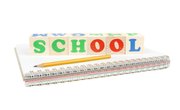A professional growth plan for a school-based speech and language pathologist should reflect his long-term occupational goals, and also should address the needs of the students served. The plan should reflect the school’s and the state’s academic goals, since students' assigned individual education plan goals are usually academic. The professional growth plan is one of the continuing education requirements set by the American Speech-Language-Hearing Association, and is often used by employers when conducting performance evaluations of speech-language pathologists.
Occupational Goals
A speech-language pathologist may have areas of preferred interest, such as phonology, early childhood language acquisition, apraxia, dysphagia or rehabilitation. In addition, after some time in practice, he may wish to expand from a comfort zone into new areas. Speech-language pathology is an attractive field because it offers a wide range of settings and clients, and even in a school-based delivery system, clients may require treatment for mild to severe disorders, depending on the school’s population.
Demographic Related Goals
A professional working in an environment where many of the students have physical disabilities will have different professional goals than one who serves, for instance, a mostly preschool Head Start population. Some schools prefer to use a pull-out method where the children come to the therapist, and others prefer an integrated method where the therapist goes into the classroom and works with the teacher. From year to year, the school may change this model, and this makes learning about a variety of service models a good professional goal. Other population factors may also affect goals – those working with children with physical disabilities may want to focus goals on areas such as dysphagia, apraxia and augmentative communication for continuing education and professional development.
Assistive Technology Goals
Assistive technology helps a wide range of clients, from children with developmental disabilities to children with autism spectrum disorders. Some forms of assistive technology also help students with language and learning disabilities, and professional goals in this area can cover a number of student and even school goals. For example, students who use assisting technology to increase their access to academics might then be able to participate in standardized testing instead of alternative assessments. Criteria for school funding often depends on a certain percentage of special needs children taking a benchmark test, and increasing the percentage of children testing becomes a school-wide goal. This benefits the students, the school and the therapist. Continuing education in this area is available from the American Speech-Language-Hearing Association and often from school districts and colleges.
IEP and School Goals
Regulations and paperwork are a constant in an speech pathologist's professional life, and keeping on top of the changing regulations of the Individuals with Disabilities Education Act , as well as Title I and state and local regulations, should be part of any professional development. Familiarity with these goals will improve school funding, impede legal issues and provide better service to students.
Related Articles
References
Writer Bio
Heather Kinn has been writing professionally since 2005, and her work appears at Dark Roast Press. She has experience in information technology and Web design and uses her background in these fields for her writing. Kinn holds a Bachelor of Science in special education and another in speech-language pathology from the University of South Florida.











